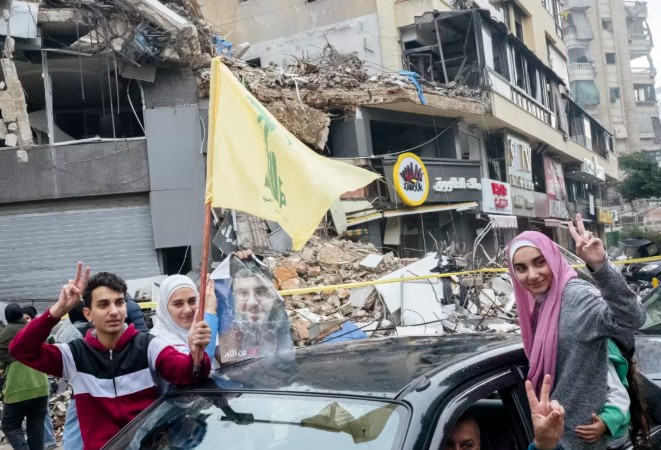The Ceasefire Begins
On Wednesday, a ceasefire agreement between Israel and Hezbollah came into effect, bringing some relief to Lebanon and Israel after months of intense conflict. The U.S.-backed deal, supported by France, aimed to stop the fighting, with both sides agreeing to a temporary halt in hostilities. The ceasefire sought to ease the devastating toll on civilians, displacing over a million Lebanese and causing significant destruction in both southern Lebanon and northern Israel. Despite this, the truce is fragile, and tension remains high as both parties navigate the complex agreement.
By Thursday, the second day of the ceasefire, much of southern Lebanon and northern Israel were quiet. There were no airstrikes or rocket fire in several areas, which marked a temporary reprieve from the relentless attacks that had defined the past months. Israeli communities near the border, where people had previously been living in constant fear of rocket fire, were free of sirens for the first time in weeks. Meanwhile, displaced Lebanese citizens began returning to their homes, though many found their neighborhoods severely damaged, especially along the border where Hezbollah had been most active.
Violations and Tensions
Despite the ceasefire, tensions quickly rose after Israel conducted an airstrike on Thursday, its first since the agreement took effect. The Israeli military claimed that the airstrike targeted Hezbollah militants who were violating the terms of the truce. The strike occurred near the southern Lebanese border, where Israel said the militants were on their way to a Hezbollah rocket facility. These types of facilities had been used by Hezbollah to launch rockets into Israel during the conflict.
In response, Lebanon’s army accused Israel of violating the ceasefire agreement multiple times on Thursday, though no direct comment from Hezbollah was immediately available. The Israeli military insisted that it would enforce the terms of the ceasefire with force if necessary, making it clear that it would respond strongly to any deviations from the agreement.
While Israel remained focused on enforcing the truce, Lebanon’s army, which had agreed to help keep the peace, made efforts to reassert control over the southern areas. They set up temporary checkpoints and began clearing roads, working to clear unexploded ordnance and to restore normalcy in war-ravaged areas. However, the situation remained tense, especially as displaced Lebanese people were still unsure when they could safely return to their homes, particularly in the areas that Israeli forces still occupied.
The Impact of the Conflict
The ongoing conflict between Israel and Hezbollah had forced hundreds of thousands of people to flee their homes, causing widespread suffering. Hezbollah’s strongholds in southern Lebanon had been the site of fierce fighting, especially after the group launched rocket attacks against northern Israel starting in October 2023. In these border regions, where Hezbollah has long had influence, Israeli airstrikes hit many communities hardest. The airstrikes heavily damaged these areas, leaving displaced families struggling to rebuild their lives.
Among those returning home was Taflah Amar, a 79-year-old woman from Baalbek, a town in Lebanon’s northeast. She had been living in Beirut during the conflict and, upon returning, found her neighborhood destroyed. She expressed deep sorrow over the damage to her community, and like many others, she questioned what she had done to deserve such suffering. Many people in the region share this grief, as the fighting flattened entire towns along the border.
Continued Tensions Despite Ceasefire Agreement
In Israel, the situation was equally tense. Although the ceasefire was in effect, many people in towns close to the border were still fearful of returning home. Gal Avraham, a resident of Margaliot, a village near the border, shared her concerns about the instability that continued to linger despite the truce. Her home had been abandoned when the fighting started, and upon returning, she found it in ruins. The damage, including rotting food and destroyed infrastructure, reflected the harsh realities of the conflict. She also expressed doubts about the long-term stability of the ceasefire, noting that sirens had sounded overnight, signaling the persistent risk of renewed violence.
While many communities in both Lebanon and Israel began the painful process of returning to their homes, the ceasefire agreement itself was still in its early stages, and much remained uncertain. According to the ceasefire, Israel will progressively leave southern Lebanon over the course of the following sixty days. In return, Hezbollah will remove its fighters from the region, and Lebanon’s army will move in to take control. The United Nations peacekeeping forces are also set to play a role in maintaining the peace.
Though the ceasefire marked a significant step toward ending the violence, it remains unclear how effectively Israel and Hezbollah will enforce it. Past ceasefire agreements, including one after the 2006 war between Israel and Hezbollah, were never fully implemented, and both sides still face a high potential for future clashes. The fragile nature of this agreement is a constant reminder of the instability in the region and the difficulty of achieving lasting peace.





